HE-35X (Drop)
back to HIFIMAN
back to measurements
home
Published: Apr-3-2019, updated: Jan-09-2022
NO SMOOTHING is applied to the shown plots. Most measurement sites have some smoothing applied which ‘irons flat’ sharp peaks and ‘wiggles’. I do not use smoothing because some info about sound quality is lost when plots are smoothed.
Aside from a small correction of the microphone itself also some correction in the lowest frequencies is applied to the plots to compensate for the perceived loss of bass when using headphones. This is described HERE in more detail.
A ‘horizontal‘ frequency response curve on the shown frequency response plots on this website thus indicates a perceived ‘flat’ tonal signature.
ALL measurements are made with a good SEAL on a flatbed measurement rig.
The shape of your head, bone structure, pad size, pad ‘softness, (compliance), hair or no hair and or wearing glasses may (drastically) change the frequency response of some headphones, so… your personal experience may differ substantially from these plots.
Frequency response (tonal balance) is the most sound-determining aspect of headphones. A horizontal line shows audible neutral response in the plots on this website. Deviations in different severities at different frequency bands have an effect on the sound character.
The bigger the deviation the stronger the effect.
Below an aid to help determining the sound character of headphones with relation to the frequency response.

HIFIMAN HE-35X (Drop)
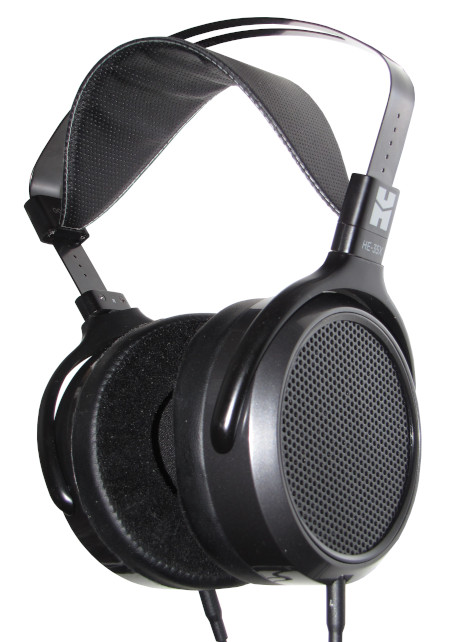
The HIFIMAN HE-35X is a dynamic over-ear headphone intended to be driven directly from portable equipment. Drop sells this for around $90.- but the second drop may be a little bit more expensive.
Because it has a low impedance (19Ω) this headphone is designed to be driven directly from portable equipment. It isn’t really suited for commuting etc. as the headphone is open and lets in ambient sound only slightly attenuated.
The ‘portable’ part here is for people who want to enjoy music when at home or in a hotel or such directly from a phone. The headphone doesn’t fold flat so it will take up quite some space in the luggage.
The earpads are much improved over the previous version (HE350) and are ‘hybrids’ with pleather outside, velours against the skin and a fenestrated pleather inside. Very comfortable. These pads also are slightly angled. They seem to be the same ones as used on the HE400SE. I would recommend NOT to remove these pads unless they have to be replaced. The pleather easily damages (is of questionable quality)
The yokes are sturdier than those of its predecessor the HE350.
Also the headphone plugs have changed. Where the HE350 had 2.5mm TS jack plugs the HE35X has 3.5mm TRS jack plugs which are a bit sturdier as well.
The headphone is not super lightweight but still feels quite light on the head. This is a very comfortable headphone due to the wide headband and comfortable pads.
The cable is clearly intended for portable usage being just 1.35m long and has a 3.5mm angled TRS jack. The cable itself is supple. I see no reason to replace it unless you want a longer cable or straight plug. It is just very slightly microphonic so you can barely hear (mechanically conducted) sounds when touching the cable.
Everyone around you can hear what you are playing and you can hear all ambient noises unattenuated. It is an open headphone.
specifications:
Type: Over ear, open
Usage: Home
Driver type: dynamic
Pads: replaceable, slanted hybrid pleather/velour
Internal pad dimensions: diameter 55mm depth: 20mm front, 25mm back
Collapsible: No but folds flat.
Headphone connector: 3.5mm TRS (marked L and R) non-locking
Cable entry: double sided
Cable: replaceable, 1.35m with gold plated angled 3.5 mm TRS plug
Driver size: 50mm Ø
Nom. power rating: (estimated 200mW)
Max. voltage: (estimated 2V)
Max. current: (estimated 100mA)
Max. S.P.L.: (estimated 116dB)
Impedance: 19Ω
Efficiency: 99dB @ 1mW
Sensitivity: 117dB @ 1V
Weight: 345 gr. (without cable), 395 gr. with cable
Colour: black
Clamping force: medium (5N)
Accessories: 6.3mm converter
Sound description:
The overall sound is warm in the mids with a present bass. The mids lack a bit of clarity/presence and have some ‘hardness’ to it but the treble is present at the correct level albeit not of high quality.
The HE350 was more ‘neutral’ and had a lot more clarity and ‘feisty’ treble up top but also was a bit ‘boring’ in the bass area and is rolled-off in sub-bass.
The HE35X is tuned more ‘modern’ and the tonal balance is much better for listening to popular music as bass is accentuated and ‘brightness’ in the recording is reduced. Audiophiles looking for a realistic sound do not need to bother but would also not be looking at this price point.
The sound is coloured and bass oriented with suppressed upper mids and then some treble up top of no more than decent quality. It is somewhat lacking in ‘air’ and ‘brilliance’ but is not completely devoid of it. It does not sound rolled-off or subdued.
The overall sound will definitely be more ‘agree-able’ for most folks that like the looks. Lush mids and full, but not overblown bass, with enough treble up top.
measurements:
Below the frequency response of the HE35X (Left, Right)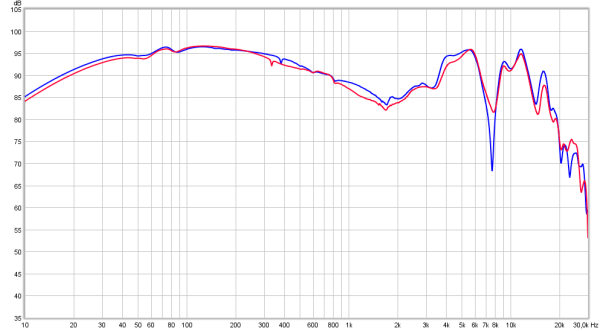 These plots were taken at around 95dB around 200Hz and appear to roll-off from 30Hz.
These plots were taken at around 95dB around 200Hz and appear to roll-off from 30Hz.
The downward slope from 300Hz to 2kHz is what makes this headphone sound ‘lush’ and lacking in clarity/presence in voices.
The treble starts to drop off from 13kHz but still has some energy up to 20kHz.
Slightly subdued in ‘air’ and ‘brilliance’ of cymbals and violins etc.
Bought a second one. This one had channel imbalance. It was slightly worse than shown below.
To get it this way I had to replace the felt disc with one that had a bigger hole in it.
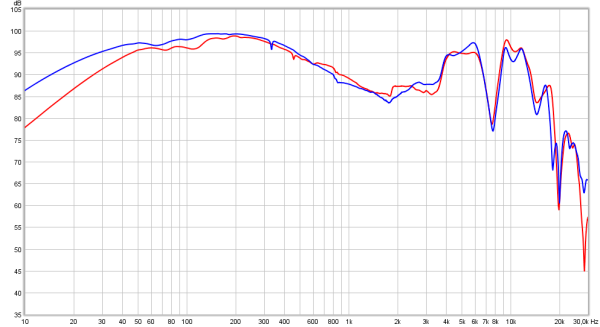
compared to
HE35X vs HE350 The difference in bass response and tonal character is very obvious.

Below, alternating, the response of the HE35X compared to some other lower priced models such as the HD58X, HE400SE, HE400i and the much more expensive but somewhat similar in response HD700.
Acoustic smoothing is used to get a better idea of the tonal balance.
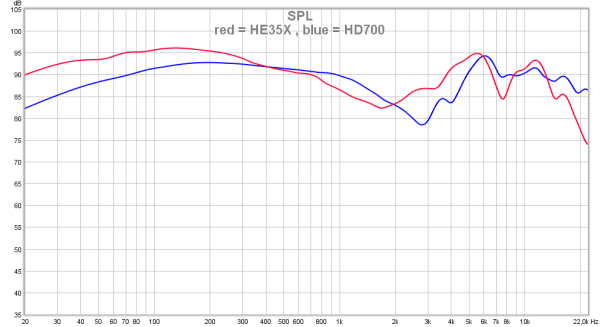 The bass response below 400Hz is substantially boosted compared to the other lower priced HIFIMAN Planar headphone models.
The bass response below 400Hz is substantially boosted compared to the other lower priced HIFIMAN Planar headphone models.
Below the phase response of the HE35X. (Left, Right)
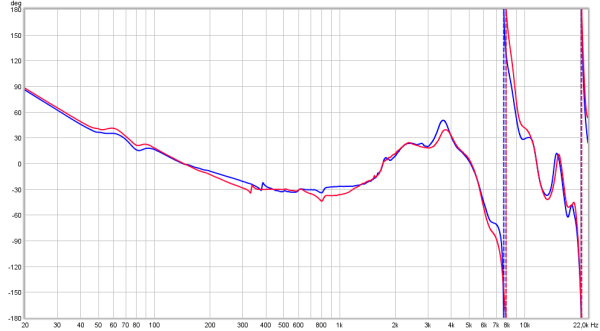 Slow phase shifts are not very audible. Sharp changes in a narrow frequency bands may well be audible. The sharp rises above 4kHz may well be audible and also be partly responsible for the perceived lesser sound quality of the treble.
Slow phase shifts are not very audible. Sharp changes in a narrow frequency bands may well be audible. The sharp rises above 4kHz may well be audible and also be partly responsible for the perceived lesser sound quality of the treble.
seal
As the seal of headphones is of importance some experiments below are showing the effect of a seal breach on the tonal balance.
(lots of) hair between the headphone and ear or an ear shape that does not allow a proper seal can/will affect the tonal balance.
Below: Perfect seal, the lighter the color the worse the seal, up to thick armed glasses not resting against the skin.
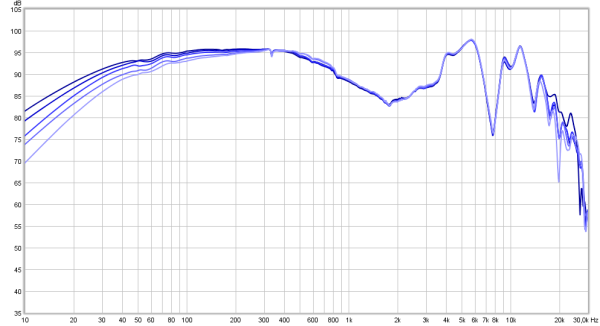
Breaking the seal does influence the lowest part of the frequency range and makes the sound less full.
Those wondering how much the grille behind the driver affects the tonal balance below a plot that shows the (prototype) HE35X with and without the grille.
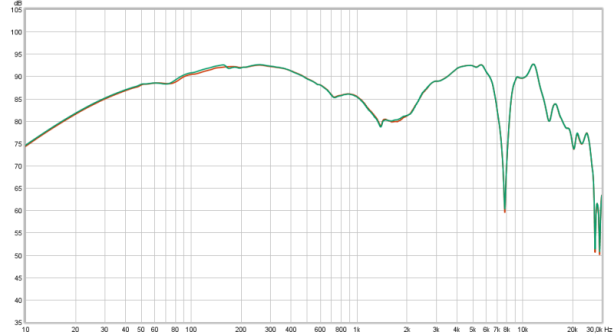
output resistance / damping-factor
As this is a dynamic headphone the frequency response may be amplifier output resistance dependent.
The HE35X is measured via a 4 different resistance outputs (0.2Ω, 10Ω, 32Ω and 120Ω). On a higher output resistance amplifier the output level will be lower of course due to voltage division. To compensate for this the amplifier is cranked up to the same level (17.3dB for 120Ω at 1kHz in this case). This way the plots are overlaid and it is easier to see how the tonal balance changes. 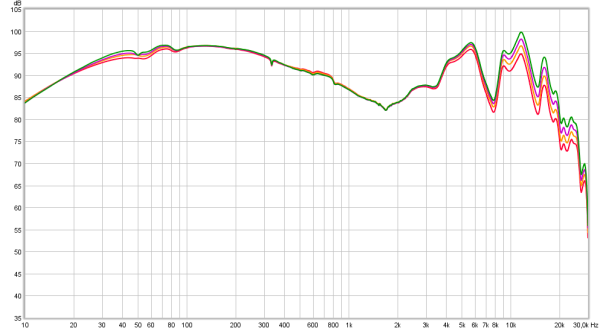 Bass response hardly changes when a higher output resistance is present. The treble response changes substantially. This is caused by the series filter in the HE35X becoming less effective.
Bass response hardly changes when a higher output resistance is present. The treble response changes substantially. This is caused by the series filter in the HE35X becoming less effective.
The fact that bass response hardly changes comes in handy when creating some passive filters.
Below the distortion measurements of the production HE-35X (left channel)
Below the distortion plot but displayed in percentages.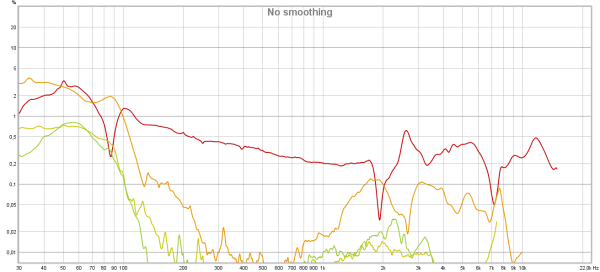 The distortion levels are kind of high for the lower frequencies. The high 3rd harmonic distortion points towards ‘compression’ of larger excursions (lower frequencies need/have larger excursions). Below 80Hz the 3rd harmonic distortion reaches 2%. This lowers the sound quality of the bass somewhat. The performance is quite similar to the HE350.
The distortion levels are kind of high for the lower frequencies. The high 3rd harmonic distortion points towards ‘compression’ of larger excursions (lower frequencies need/have larger excursions). Below 80Hz the 3rd harmonic distortion reaches 2%. This lowers the sound quality of the bass somewhat. The performance is quite similar to the HE350.
For the mids and treble the 2nd harmonic distortion is much lower.
Below the distortion measured at 80dB SPL.
 We see the distortion drop but there is still a lot of 3rd harmonic distortion indicating that there already is some compression at 80dB SPL already.
We see the distortion drop but there is still a lot of 3rd harmonic distortion indicating that there already is some compression at 80dB SPL already.
Linearity
The headphone is measured 4 times. Once at 70dB, 80dB, 90dB and 95dB SPL.
When the traces are the same shape then there is no compression which, sadly, is not the case here.
This will be more clearly visible when overlaid and amplified in vertical scale (2dB/div) in the plot below. 70dB, 80dB, 90dB and 97dB (left channel)
 The low frequency extension changes when the level increases. At lower listening levels there is about 2dB more lows than at higher levels. This by itself is not an issue because of the way our hearing works this kind-off compensates for this (but not nearly enough). The problem is increased distortion at higher levels as can be seen in the distortion plots above.
The low frequency extension changes when the level increases. At lower listening levels there is about 2dB more lows than at higher levels. This by itself is not an issue because of the way our hearing works this kind-off compensates for this (but not nearly enough). The problem is increased distortion at higher levels as can be seen in the distortion plots above.
Below the CSD of the HE35X. (Left and Right are overlaid) The driver is well damped and above 2kHz there really is little to complain about. No deal breaking resonances are seen.
The driver is well damped and above 2kHz there really is little to complain about. No deal breaking resonances are seen.
Below the group delay plot of the HE35X.  There is some pad bounce around 60Hz, weirdly enough L and R differ a bit. Around 350Hz there is something weird happening. This is also visible in the in the frequency response (a very narrow and small dip). This looks like a driver issue.
There is some pad bounce around 60Hz, weirdly enough L and R differ a bit. Around 350Hz there is something weird happening. This is also visible in the in the frequency response (a very narrow and small dip). This looks like a driver issue.
Below the spectrum plot of the HE-35X. 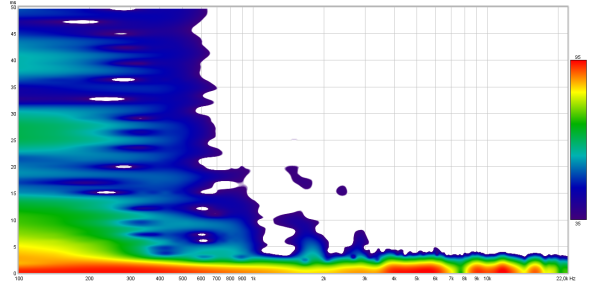 This too looks quite good. Lower frequencies are damped quite well. At 1.8kHz there is some very short lived lingering at very low amplitudes and most likely not even audible.
This too looks quite good. Lower frequencies are damped quite well. At 1.8kHz there is some very short lived lingering at very low amplitudes and most likely not even audible.
The step response (Left, Right) below shows the sub-bass is slightly rolled-off. This is evident by the horizontal trace dropping slowly after 2ms. The resonances are fairly short lived (< 1ms) and not high in amplitude. The impulse response is 4dB lower than the mids and shows an emphasis in the lower-mids/ upper-bass. It thus sounds warm and bassy. 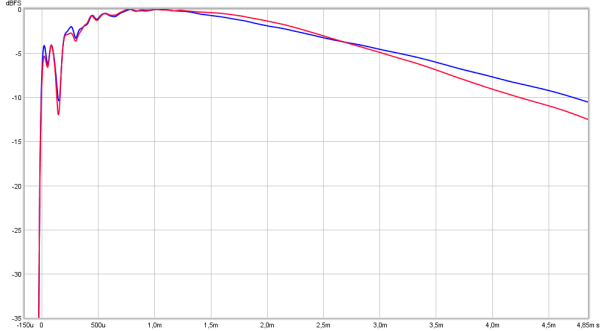 The dip is the 7kHz ‘notch’ and is a bit deeper in the HE35X than in the HE350. That notch may well be responsible for the treble quality which is just decent.
The dip is the 7kHz ‘notch’ and is a bit deeper in the HE35X than in the HE350. That notch may well be responsible for the treble quality which is just decent.
modification
Below a picture of the front and rear side of the driver.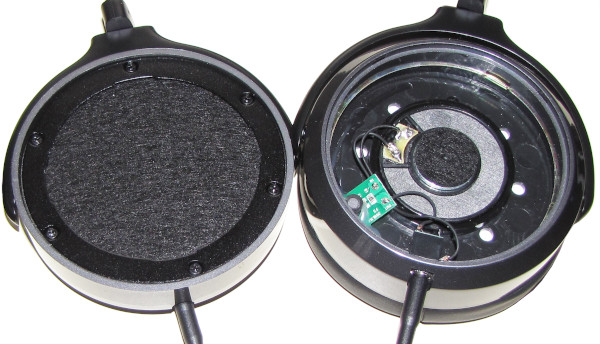 The front of the driver is damped with acoustic paper. The rear of the driver shows a filter like the one I designed for the HE350. This lowers the sharpness. Also the driver is modified a bit compared to the original HE350 driver. The paper ring on the rear does not have a hole any more (you can see it is taped off using a round sticker) and the magnet now has a felt disc covering it with a small hole in the middle.
The front of the driver is damped with acoustic paper. The rear of the driver shows a filter like the one I designed for the HE350. This lowers the sharpness. Also the driver is modified a bit compared to the original HE350 driver. The paper ring on the rear does not have a hole any more (you can see it is taped off using a round sticker) and the magnet now has a felt disc covering it with a small hole in the middle.
This lowered distortion/compression and extended the frequency response.
The frequency response of the HE35X can be improved by changing the filter. Unfortunately this is a much more complex filter so it is only mounted in the 2 models I have here.
Below a picture of the filter built into the cup.
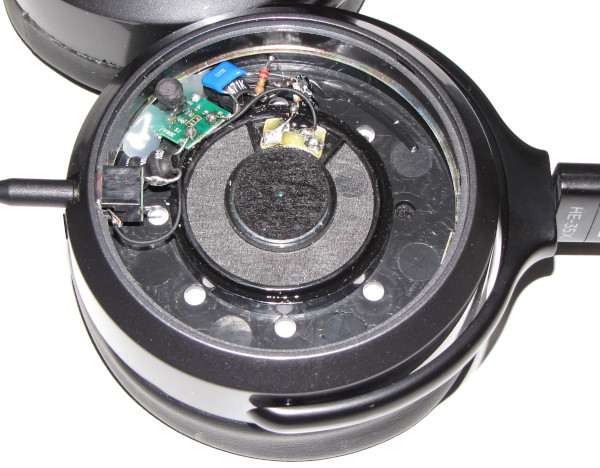 Below the schematic of the filter (for those interested). This filter is not sold as an inline filter.
Below the schematic of the filter (for those interested). This filter is not sold as an inline filter.
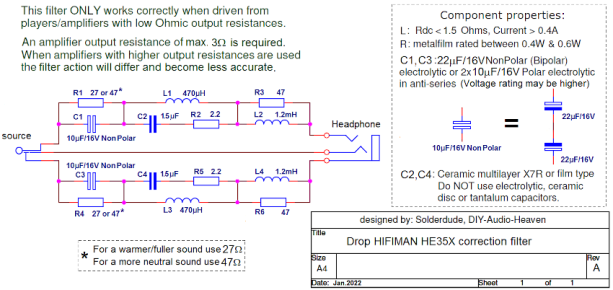 Below the difference between stock and filtered.
Below the difference between stock and filtered.
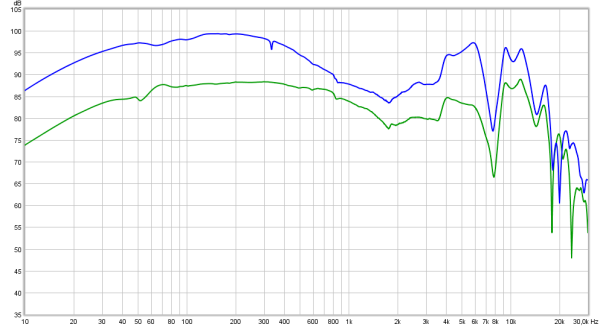 The efficiency drops substantially but the response is flatter.
The efficiency drops substantially but the response is flatter.
Below alternating the frequency response of the filtered vs stock HE35X (left, right)

This modified HE35X is for sale
conclusion
The HE35X is an improved HE350 on several points. The price has not changed so this is still a cheap HIFIMAN headphone with a pleasant sound which is easily driven by portable equipment and directly from phones, tablets etc. The pads and thus comfort is changed. The driver is now angled which helps a bit with the stereo imaging. The headphone connectors are now 3.5mm instead of 2.5mm TRS.
It has a warm and laid-back sound. Don’t expect this to be a cheap alternative to the orthodynamic offerings from HIFIMAN despite the similar looks.
At this the price point there some alternatives but may not be as comfortable nor have similar looks.
